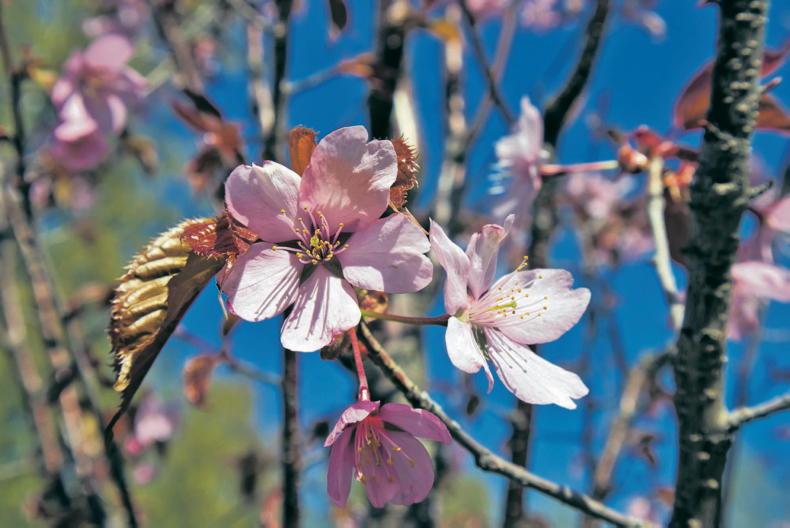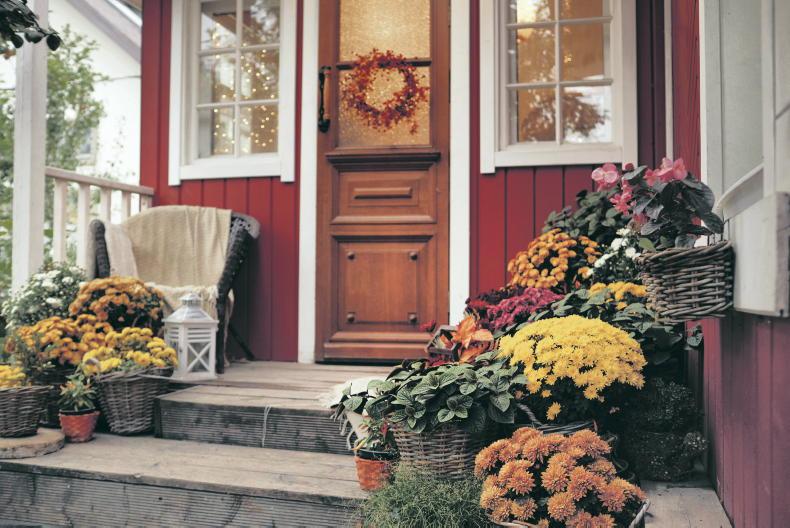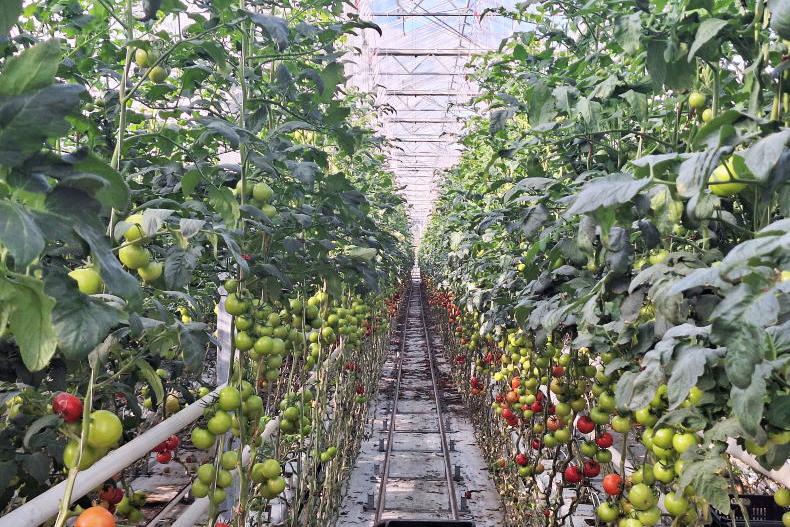With only a few nights of frost, this has proven to be an excellent year of autumn colour. One of the first trees to show autumn colour is Sargent’s cherry, making a lovely stained-glass show of red, purple, green and yellow. Also, the flat-topped Yoshino cherry makes a beautiful display.
Hornbeam, birch and beech all colour to yellow shades before falling, although autumn colour is rarely a consideration when these trees are planted.
Common ash, now mostly dead or dying, often shows good colour for a brief period, and the yellow ash, Fraxinus excelsior ‘Jaspidea’ is truly splendid.
Norway maple and red oak shows superb yellow and red colour on a large tree. On a smaller scale, Japanese maple is the best of all woody plants for autumn colour with witch hazel and the related parrotia not far behind. Blueberry is one of the best shrubs for this purpose.
Staghorn sumach is usually very good, especially on dry, poor soil. The sweet gum or liquidamber is generally grown especially for its rich red and purple show. Dogwood is very good with deep crimson colour, also the deciduous forms of viburnum, hydrangea, rugosa rose and magnolia are excellent.
Autumn colour
The Chinese spindle, Euonymus alatus, is grown only for its spectacular and reliable brilliant crimson colour. Amelanchier is also good for autumn colour and, like the cherries, witch hazel, magnolia and viburnum, its autumn show is a bonus that follows on from its spring flowering.
Some climbers add to the party, notably Virginia creeper and Boston ivy with a rich show of red and yellow on house walls. The climbing hydrangea makes a sheet of butter-yellow. Celastrus can be very good too in yellow.
The crimson glory vine, Vitis coignetiae, is superb as are its grapevine relatives and the autumn colour on kiwi-fruit. Berried shrubs and trees with bright yellow or red fruits can be sparkling, such as crab-apple, mountain ash and hawthorn, cotoneaster, pyracantha and distinctive purple berries of callicarpa.
Although autumn colour is generally associated with trees and shrubs, some non-woody plants can provide quite a good show of too. Hosta often changes to a light yellow colour. Euphorbia griffithii changes to yellow and red. Lysimachia clethroides changes to yellow with red stems while Lobelia tupa can produce beautiful shades of pink and yellow. Miscanthus changes to yellow with red touches in some cases. Other grasses, such as feather grass, bleach out to a light sandy colour. Persicarias change to yellow and red, and some kinds make brown shades.
Autumn-flowering bulbs and perennials are invaluable. Hardy cyclamen starts the parade in August, followed by colchicum in September, nerines in October and schizostylis in November.
Asters start in August and continue into late October, such as ,‘Professor Anton Kippenburg’ and ‘Little Carlow’, two blue-flowered kinds that offer a touch of yellow contrast to the general yellow, orange and red of autumn.
Chrysanthemums are great late-season plants, the earliest ones in September and running into November. All of the plants mentioned are worth growing.
Potting compost from leaves
As the last of the leaves come down, there is a necessity to take these off lawns and paths. On a lawn, the leaves can badly damage the growth of grass by shutting off sunlight. On paths and driveways, leaves can be slippery and can cause staining on concrete. Leaves falling into a garden pond can cause algal growth and deprivation of oxygen to fish.
Despite being a nuisance, leaves can be a valuable resource. They can be gathered up and made into a pile to break down as leaf-mould. This is a fine replacement for compost based on peat and can be used as a potting medium, mixed with good garden soil. The best leaves for making leaf-mould are hard leaves like those of oak, sweet chestnut or beech.
Flowers: In colder areas, lift dahlias, begonias and gladiolus in frosty localities to prevent damage, or cover them with soil in milder areas. Bedding plants can be put in.
Fruit, vegetables and herbs: Plant all kinds of new fruit trees and bushes. Spread compost before digging in. Dig over vegetable ground, removing old crops to break the pest and disease cycle. Control weeds.
Lawns: Grass tends to grow during mild spells and an occasional mowing, about once a month, will keep it neat.
Trees, shrubs and roses: Planting of bare-root deciduous trees, hedging and shrubs can continue during dry weather. Do not plant in wet conditions.
Q&A: What can I grow during the winter?

Hanging baskets can add a nice pop of colour during the winter months.
I love gardening in the summer, but not sure what I can plant in the winter, do you have any easy suggestions for adding a pop of colour to the garden? - Ann-Marie O’Sullivan, Athy.
Use winter-blooming flowers like pansies, hellebores, and witch hazel to infuse color into the landscape with winter garden planters. These hardy blooms add pops of vibrancy.
A popular go-to to bring some colour into your garden is a winter hanging basket. There’s a wealth of hardy plants to choose from and the combinations for winter hanging baskets are endless; hardy pansies and violas are guaranteed to bring cheerful pops of color right through winter into spring and they are available in a huge array of shades.
Ivy is one of the best and easiest to care for in hanging basket plants. It’s a fast-growing plant that can quickly become invasive in the ground so it’s ideal to restrict it to a container.
With only a few nights of frost, this has proven to be an excellent year of autumn colour. One of the first trees to show autumn colour is Sargent’s cherry, making a lovely stained-glass show of red, purple, green and yellow. Also, the flat-topped Yoshino cherry makes a beautiful display.
Hornbeam, birch and beech all colour to yellow shades before falling, although autumn colour is rarely a consideration when these trees are planted.
Common ash, now mostly dead or dying, often shows good colour for a brief period, and the yellow ash, Fraxinus excelsior ‘Jaspidea’ is truly splendid.
Norway maple and red oak shows superb yellow and red colour on a large tree. On a smaller scale, Japanese maple is the best of all woody plants for autumn colour with witch hazel and the related parrotia not far behind. Blueberry is one of the best shrubs for this purpose.
Staghorn sumach is usually very good, especially on dry, poor soil. The sweet gum or liquidamber is generally grown especially for its rich red and purple show. Dogwood is very good with deep crimson colour, also the deciduous forms of viburnum, hydrangea, rugosa rose and magnolia are excellent.
Autumn colour
The Chinese spindle, Euonymus alatus, is grown only for its spectacular and reliable brilliant crimson colour. Amelanchier is also good for autumn colour and, like the cherries, witch hazel, magnolia and viburnum, its autumn show is a bonus that follows on from its spring flowering.
Some climbers add to the party, notably Virginia creeper and Boston ivy with a rich show of red and yellow on house walls. The climbing hydrangea makes a sheet of butter-yellow. Celastrus can be very good too in yellow.
The crimson glory vine, Vitis coignetiae, is superb as are its grapevine relatives and the autumn colour on kiwi-fruit. Berried shrubs and trees with bright yellow or red fruits can be sparkling, such as crab-apple, mountain ash and hawthorn, cotoneaster, pyracantha and distinctive purple berries of callicarpa.
Although autumn colour is generally associated with trees and shrubs, some non-woody plants can provide quite a good show of too. Hosta often changes to a light yellow colour. Euphorbia griffithii changes to yellow and red. Lysimachia clethroides changes to yellow with red stems while Lobelia tupa can produce beautiful shades of pink and yellow. Miscanthus changes to yellow with red touches in some cases. Other grasses, such as feather grass, bleach out to a light sandy colour. Persicarias change to yellow and red, and some kinds make brown shades.
Autumn-flowering bulbs and perennials are invaluable. Hardy cyclamen starts the parade in August, followed by colchicum in September, nerines in October and schizostylis in November.
Asters start in August and continue into late October, such as ,‘Professor Anton Kippenburg’ and ‘Little Carlow’, two blue-flowered kinds that offer a touch of yellow contrast to the general yellow, orange and red of autumn.
Chrysanthemums are great late-season plants, the earliest ones in September and running into November. All of the plants mentioned are worth growing.
Potting compost from leaves
As the last of the leaves come down, there is a necessity to take these off lawns and paths. On a lawn, the leaves can badly damage the growth of grass by shutting off sunlight. On paths and driveways, leaves can be slippery and can cause staining on concrete. Leaves falling into a garden pond can cause algal growth and deprivation of oxygen to fish.
Despite being a nuisance, leaves can be a valuable resource. They can be gathered up and made into a pile to break down as leaf-mould. This is a fine replacement for compost based on peat and can be used as a potting medium, mixed with good garden soil. The best leaves for making leaf-mould are hard leaves like those of oak, sweet chestnut or beech.
Flowers: In colder areas, lift dahlias, begonias and gladiolus in frosty localities to prevent damage, or cover them with soil in milder areas. Bedding plants can be put in.
Fruit, vegetables and herbs: Plant all kinds of new fruit trees and bushes. Spread compost before digging in. Dig over vegetable ground, removing old crops to break the pest and disease cycle. Control weeds.
Lawns: Grass tends to grow during mild spells and an occasional mowing, about once a month, will keep it neat.
Trees, shrubs and roses: Planting of bare-root deciduous trees, hedging and shrubs can continue during dry weather. Do not plant in wet conditions.
Q&A: What can I grow during the winter?

Hanging baskets can add a nice pop of colour during the winter months.
I love gardening in the summer, but not sure what I can plant in the winter, do you have any easy suggestions for adding a pop of colour to the garden? - Ann-Marie O’Sullivan, Athy.
Use winter-blooming flowers like pansies, hellebores, and witch hazel to infuse color into the landscape with winter garden planters. These hardy blooms add pops of vibrancy.
A popular go-to to bring some colour into your garden is a winter hanging basket. There’s a wealth of hardy plants to choose from and the combinations for winter hanging baskets are endless; hardy pansies and violas are guaranteed to bring cheerful pops of color right through winter into spring and they are available in a huge array of shades.
Ivy is one of the best and easiest to care for in hanging basket plants. It’s a fast-growing plant that can quickly become invasive in the ground so it’s ideal to restrict it to a container.










SHARING OPTIONS